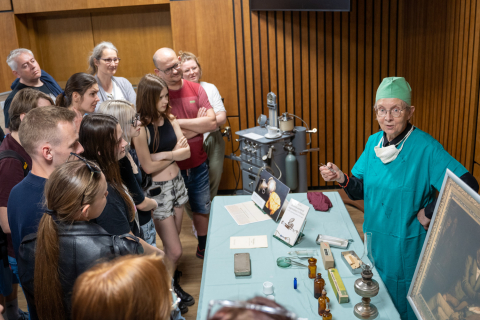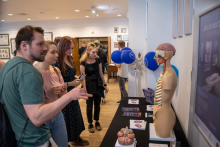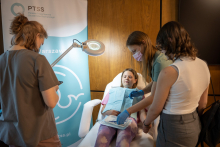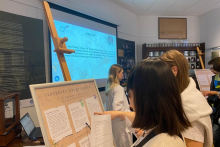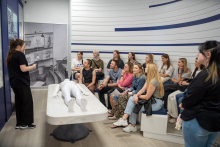The hit of this year's edition were the lectures, and the J. Zaorski hall at the Library and Information Center (CBI), where they were held - was bursting at the seams. Everyone wanted to learn the secrets of the brain.
Lecture session
The lecture session began with Prof. Bogdan Ciszek, Head of the Department of Descriptive and Clinical Anatomy MUW, who gave a brief history of neurosurgery. However, he began by explaining how the nervous system is built and what neurosurgery does. The professor also showed what eighteenth- and nineteenth-century trepans looked like, as trepanation is the symbol of neurosurgery.
- How did it start? Here are skulls that come from archaeological sites that are many thousands of years old - said Prof. Ciszek, presenting photos of skulls with trepanation marks. - Here is an example from a collection from South America, where you can see that several trepanations were made. And additional marks on the skull indicate that the person to whom the skull belonged survived for at least several years after the “operation.”
The professor traced the stages in the history of trepanation, listing the most important scientists who contributed to the development of knowledge about the brain. Among them were: Paul Broca, Wilder Penfield, Victor Horsley and Prof. Jerzy Choróbski.
During the lecture, it was also possible to see photos of cases - that is, open skulls with various pathologies, such as aneurysms, hemangiomas, or brain tumors. Modern methods of neurosurgical treatment were also presented.
This was followed by a very interesting lecture by Dr. Stanisław Szlufik from the Department of Neurology MUW. The doctor focused on how to improve brain function and memory. He presented 12 recommendations that can be helpful:
- Get mental stimulation
- Perform physical exercises
- Improve your diet (eat berries, fatty fish, nuts).
- Improve your blood pressure
- Improve your blood sugar levels
- Improve your cholesterol
- Consider low-dose aspirin
- Avoid tobacco
- Don't overuse alcohol
- Take care of your emotions
- Protect your head
- Build relationships with other people
Another lecture was given by Dr. Maria Turos from the Department of Medical Ethics and History of Medicine - about how anesthesiology has changed over two centuries. And the lecture session was closed by Dr. Magdalena Łazarewicz from the Department of Health Psychology, presenting a recipe for a happy brain.
Various exhibitions and student booths
Specially for the Night of Museums, our MHM prepared an exhibition entitled “Secrets of the Brain.” During the tour of the exhibition, you could learn how patients used to be anesthetized for surgery - Dr. Maria Turos talked about it at her stand. You could also learn about the principles of painkillers (the stand of the Polish Society of Pharmacy Students PTSF) and perform a free dental check-up. It was carried out by students of the Faculty of Medicine and Dentistry active in the Polish Society of Dental Students PTSS. It was also possible to pet a Paro seal, which is a super-robot used in therapy for e.g. stress relief. It was also worth seeing the exhibition to learn many surprising facts, such as that the brain makes up only 2 percent of an adult's body weight, consumes 20 percent of the energy used by the body and burns 400 calories at a constant rate no matter what we do.
The other exhibitions were also very popular with visitors: “Professor Jerzy Choróbski - the founder of the first neurosurgery clinic”, “Library of the Pharmacist”, “History of the Faculty of Pharmacy”, “History of the Faculty of Dentistry” and “Vita Brevis ars Longa.”
The queues also lined up at the booths. The longest one was for the booth at which one could learn about your personality model by filling out an appropriate test beforehand. The tests were prepared by specialists from the Department of Psychology MUW. So were the games, puzzles and quizzes that could be solved to train the brain.
As last year, there were also stands prepared by IFMSA students in the “Health under control” series. At them, sugar level testing and blood pressure measurement were performed. One could practice on a laparoscopic surgery trainer and register in the DKMS bone marrow donor database.
Lessons in anatomical theater
Also open to the public was an anatomical theater with a state-of-the-art illuminated phantom called “Cake” at the university. Here the hosts were medical students. They talked about how the nervous system and its cells are built, and what role they play in the body. They explained what short-term, long-term and procedural memory is. Their presentation also included interesting facts, such as the case of Henry Molaison, who had his hippocampus excised by a surgeon in order to cure epilepsy. The result was that the patient was unable to remember current events.
The students also told the story of the first lobotomy (destruction of the frontal lobe), which was done by accident. And it was the strange case of Phineas Gage. The man suffered an unimaginable accident. A rod with a diameter of 3 cm pierced his head below the left cheekbone and exited through the top of the skull. Unbelievable, but Gage survived and after a few months returned to work. The whole event, however, did not leave his personality unaffected. He became aggressive, incapable of planning, and difficult to deal with other people. It turned out that the iron had destroyed a large part of his left frontal lobe. This gave rise to a discussion of the fact that the brain is not a homogeneous structure, and has some specific structures that perform different functions.
The Night of the Museums at MUW ended as early as 1 a.m. on Sunday, and it was really worth staying up late!
